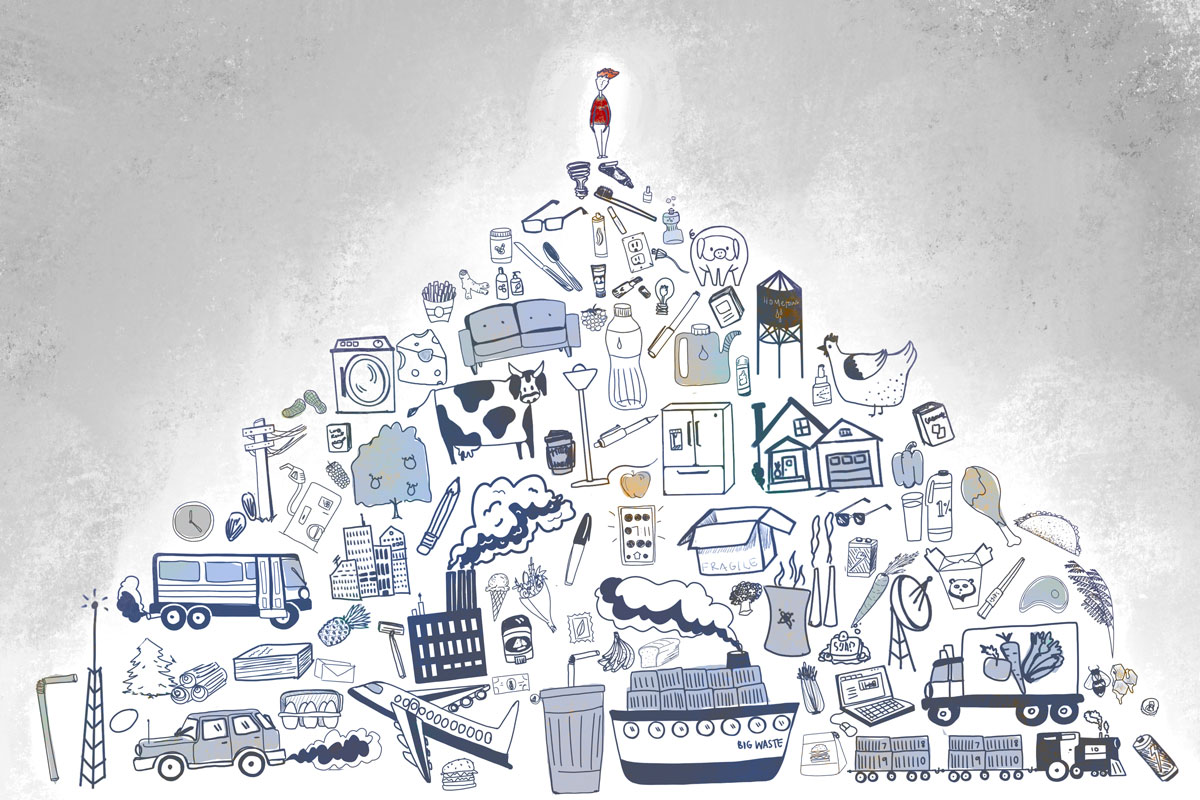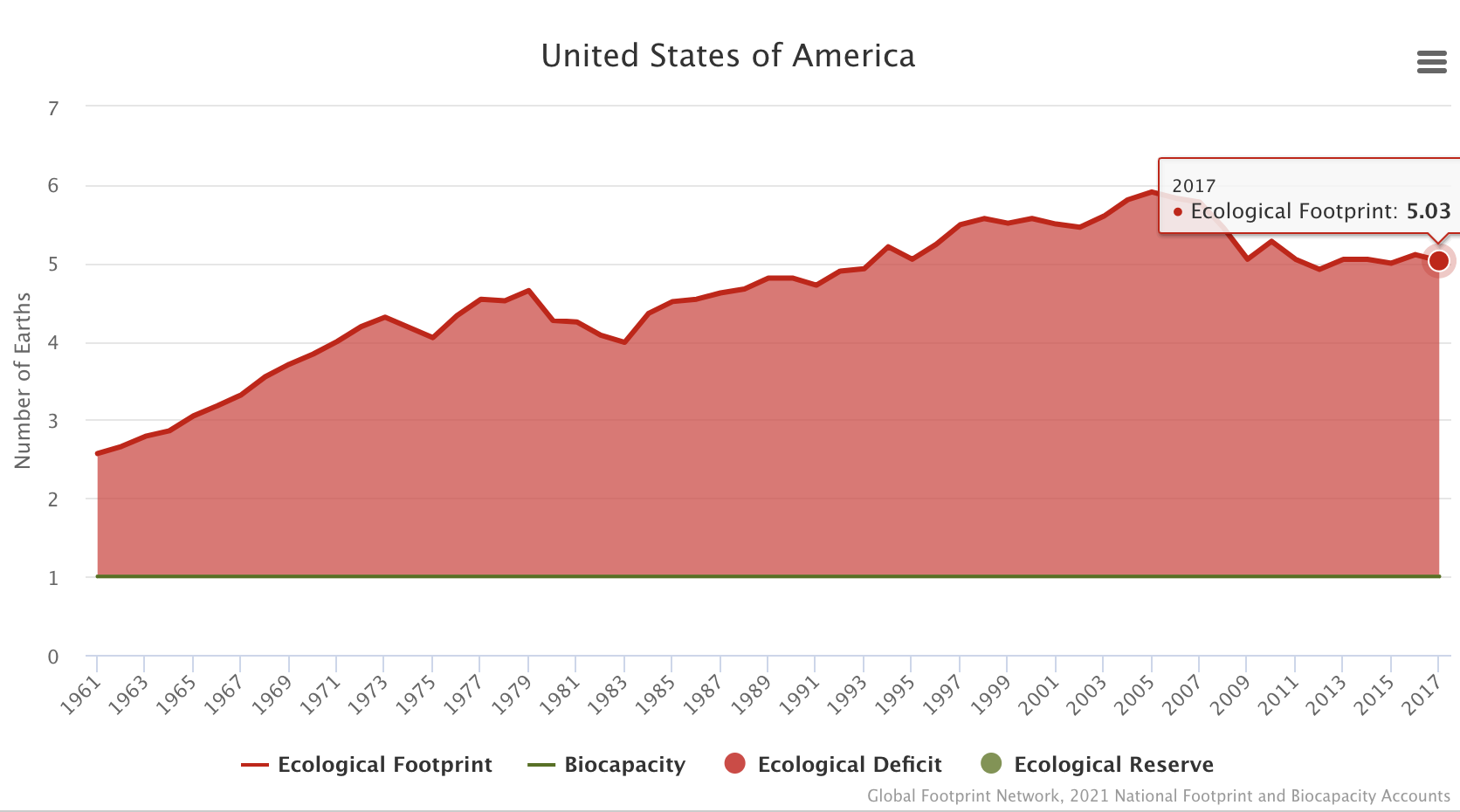
The Ecological Footprint is the estimated biologically productive area required to produce the resources a person consumes and to assimilate their waste.
Graphic by Jessica Pace | The Washtenaw Voice
by DOINA PLOP
Deputy Editor
An increasing number of youths seem to take environmental issues to heart and demand limiting pollution emissions to avoid having huge impacts on the environment and their future.
The 2020 UNEP Emissions Gap Report finds that “despite a brief dip in carbon dioxide emissions caused by the COVID-19 pandemic, the world is still heading for a temperature rise in excess of 3°C this century – far beyond the Paris Agreement goals of limiting global warming to well below 2°C and pursuing 1.5°C.”
That might seem like a small difference, but according to Earth Observatory (NASA), “when global warming has happened at various times in the past two million years, it has taken the planet about 5,000 years to warm 5 degrees. The predicted rate of warming for the next century is at least 20 times faster. This rate of change is extremely unusual.”
Many recognize Greta Thunberg, a Swedish environmental activist that started her action for climate change at only 15 years old and inspired numerous students around the world to seek change and live more sustainably. Yet, there are millions of young activists that are not as well known but have a meaningful impact in their community.
Lauren Singer is a young American environmental activist that fitted all of her waste since 2012 in a 16 oz mason jar. She opened a zero waste shop called Package Free and a personal blog called Trashisfortossers where she offers “tips, tricks, and tools for reducing waste daily, insight on environmental issues and what can be done to solve them, as well as recipes, guides, DIYs that make sustainable living simple, cost-effective, and fun.”
Singer is one of the many young activists trying to reduce waste and pollution emissions.
According to the Pew Research Center, “a majority of Americans continue to say they see the effects of climate change in their own communities and believe that the federal government falls short in its efforts to reduce the impacts of climate change.”

According to the Global Footprint Network, there were ~ 12 billion hectares of biologically productive land and water areas on Earth in 2017. Dividing by the number of people alive in that year (7.5 billion) gives 1.6 global hectares per person. The United States’ Ecological Footprint was estimated to be 8.04 global hectares per person; If everyone lived like that, we would have needed 5.03 Earths.
Graphic by Global Footprint Network, 2021 National Footprint and Biocapacity Accounts
According to the Global Footprint Network, in 2017 the United States’ Ecological Footprint was estimated to be 8.04 global hectares per person; If everyone lived like that, an additional 4.03 Earths would be necessary.
The Ecological Footprint is the biologically productive area required to provide everything we consume and it can be compared to biocapacity, which is the productive area that exists on our planet. A person’s Ecological Footprint is associated with food, mobility, and goods and it can be easily modified through lifestyle choices.
Some students currently attending an Environmental Science class at WCC were asked to use an ecological footprint calculator to get an idea of their ecological footprint. After taking the test, they shared their results and thoughts about the topic.

Self-portrait photograph of WCC students: Tamar Cawthra, Kendrix Szilagyi, Caelan Saunders, and Maddy Brown.
Photo collage by Jessica Pace | The Washtenaw Voice
“My ecological footprint was 7.7. It’s about the same as the average American’s ecological footprint, so that’s a little encouraging. However, I definitely feel moved to reduce it more. Personally, I plan on taking steps to change my eating habits, and that may look like consuming less red meat, shopping for organic produce locally, or cutting back on processed foods and snacks,” said Maddy Brown, WCC student and environmental science major.
“My ecological footprint costs about 1.8 Earths and I use about 3.1 hectares. I absolutely think I should reduce it! I’m currently working toward eliminating single-use plastics, saving up to buy a more fuel-efficient car, and shopping local. However, even when I achieve all of these things, I will be on the lookout for more ways to be self-sustaining. Technology advances every day and I’ll always try to make a positive change,” said Caelan Saunders, WCC student and graphic design major.
“Due to living in a small town, primarily, as well as in a rural setting, my household’s energy usage is dependent on electricity. We live in a small residential area in Howell, with little access to any recycling facilities or places with affordable, organic foods.
Accumulating our 400-plus miles driven per week, our ecological footprint is 4 GHA — about 2.3 Earths if everyone lived like us. Our easiest way of reducing it would be to limit our consumption of resources,” said Tamar Cawthra, WCC student and liberal arts transfer major.
“My ecological footprint showed that we would need 2.4 Earth’s if everyone lived the way I did. This was incredibly surprising to me because I had always considered myself a ‘green’ person. After getting this score I began to ask myself more in-depth questions about where I could eliminate waste because I think that everyone can reduce it. The best way to reduce is to simply use less, as to not create any waste in the first place,” said Kendrix Szilagyi, WCC student and environmental policy and planning major.
What are some ways to reduce your ecological footprint?
Limit your use of plastic. Avoid using disposables. If you enjoy buying coffee every day, avoid tossing 365 cups in the landfill by bringing your own reusable cup. When you go to the grocery store, bring your shopping bags and produce tote bags rather than using disposable plastic ones. If you can, always avoid buying items that are unnecessarily wrapped in plastic. According to EPA, “Containers and packaging make up a major portion of municipal solid waste (MSW), amounting to 82.2 million tons of generation in 2018 (28.1 percent of total generation).”
Buy fewer clothes or opt for second-hand clothes. Choose to buy clothing and accessories only if you actually need them. Buy from environmentally friendly shops. Avoid synthetic materials. The fashion industry plays a huge role in generating waste and pollution emissions.
Change diet and shopping habits. Choosing to buy locally-grown food, limiting the amount of meat, and avoiding processed foods are great first steps. Not only you will be more environmentally sustainable but also healthier.
Use public transportation. Biking, walking or carpooling instead of driving solo are other ways to cut down carbon emissions.
Overall, try to reduce your waste. Switch to compostable or recyclable items. Check your local recycling structure for instructions on how to recycle electronics and other appliances.
According to Recycle Ann Arbor, “electronic waste or large appliances should not be put into (or placed next to) the curbside recycling or trash carts. The components in these items (arsenic, lead, mercury, Freon, etc.) need to be recycled separately/properly and should not be mixed in with the contents of residential recycling or trash.”
Visit Recycle Ann Arbor for more tips and instructions.
EPA estimated that “in 2018 in the United States, more food reached landfills and combustion facilities than any other single material in our everyday trash.” When food goes to the landfill, it rots and produces methane gas, which is a greenhouse gas at least 28 times more potent than carbon dioxide.
If you can’t reduce or donate wasted food, you can compost. Composting is the process of creating ideal conditions for the rapid decomposition of organic materials. According to EPA, “properly composted organics (wasted food and yard waste) improve soil health and structure, improve water retention, support more native plants, and reduce the need for fertilizers and pesticides.”
For more information about how to compost, visit the EPA’s website.
According to the environmental activists, all these steps make a difference. They are a positive change, no matter how big or small.
How can you promote sustainability on a large scale?
As the Global Footprint Network suggests, a person’s Ecological Footprint includes both personal and societal impacts. This is why, to achieve sustainability, you must focus on both your personal lifestyle as well as influencing your governments to make changes.
WCC students seem to be well aware of it and they have a few solutions in mind.
“The biggest threats to sustainability lie between affluence and inequality of wealth. While every person has a responsibility to do their part, it is unrealistic to expect ‘normal’ people like you or me to make up for the emissions of the largest companies and factories of the world. Inequality of wealth has made corporations invincible against the regulations currently placed on them, and the affluence of today’s society has made the standard of living unsustainable,” said Szilagyi.
“Some households, like mine, can’t afford to make a complete environmental change. Companies sure can, yet choose not to. Carbon taxes could be one economic change, but it would rely on actual regulation and distribution of taxes towards change. Industries would need to completely change their means of production, sacrificing a larger purchase for a long term effect of less waste and pollution,” said Cawthra.
“The biggest polluters in the world are multi-national corporations and government militaries. With such vast amounts of wealth, the only way to properly combat these corporations and organizations is with regulation, outlawing these destructive behaviors. However, the government needs to make sure there are technology and jobs to replace all the ones it will be taking away. It will require bold vision and commitment, but if the government compromises, these efforts will fail just like every other government-led environmental push,” said Saunders.
Many Americans share similar sentiments as our students. According to the Pew Research Center, “84 percent of U.S. adults support providing a business tax credit for carbon capture technology that can store carbon emissions before they enter the atmosphere.” Additionally, “Most Americans also support tougher restrictions on power plant emissions (80 percent), taxing corporations based on the amount of carbon emissions they produce (73 percent) and tougher fuel-efficiency standards for automobiles and trucks (71 percent).”
Can one make money for being environmentally friendly?
According to Tradewater, “a company committed to cleaning up the environment can be just as successful – if not more so – than a company that achieves its goals without regard to environmental impact.”
Tradewater, a company formed in 2016, collects high impact greenhouse gases to safely and efficiently destroy them, preventing them from being released into the atmosphere. By collecting and destroying greenhouse gases, companies like Tradewater gain carbon offset credits –that they can then sell to other companies– and make profits. This is possible due to California’s cap-and-trade market, which places a cap on the number of pollution emissions. This method, ideally, allows the more environmentally friendly companies to make profits by selling their excess offset credits and penalizes the less environmentally friendly companies that need to buy more offset credits in order to pollute more.
According to Tradewater, their company offers “top dollar for CFC refrigerants like R-12, R-500, R-113, and R-114.” If you have any old refrigerants, contact Tradewater. They will pay you to come and pick up the hazardous material and safely dispose of it for you.
For more information about Tradewater, visit their website here.
What is your ecological footprint?
You can find out by using one of the many free online calculators available to the public (for example, Henkel or GFN). The footprint calculators provide an estimate of the CO2 emissions that one person produces during a full year. It is intended to provide an introduction to the topic and help identify the key elements for reducing a person’s CO2 footprint.
